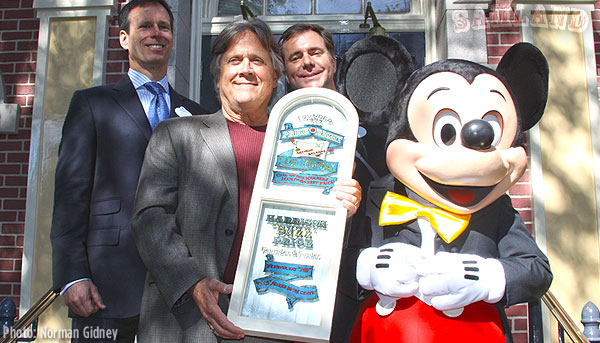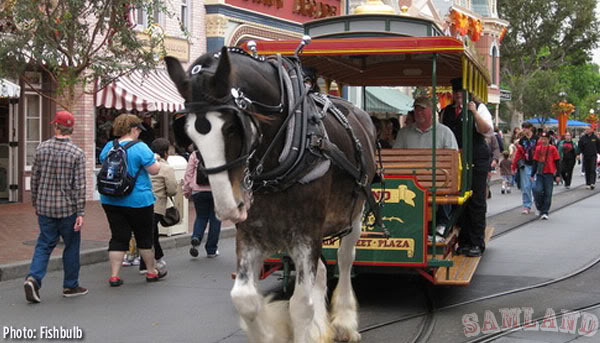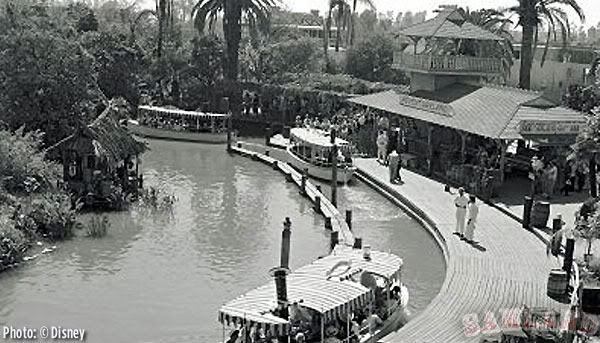Harrison “Buzz” Price was a visionary businessman who profoundly influenced Walt Disney and many decisions regarding the theme parks and how and where they should be built. Two years ago, Sam Gennawey made it his mission to get Buzz a Window on Main Street. Early this week, that dream came true, as Buzz was posthumously awarded a window in an early morning ceremony. Here’s part two of Sam’s original article with some new photos from the window ceremony added to the bottom. You can read PART one of this story here.- Dusty
Last week, we rediscovered a true Disney Legend who was perhaps more responsible for Disneyland landing in an Anaheim orange grove than any other man but Walt Disney himself. A little background for those who missed Where’s The Window Part I. I was admiring the worthy tradition at Disneyland and the Magic Kingdom to honor those who have made an impact by placing their name on a window on Main Street. Walt Disney himself started the idea. According to Marty Sklar, the rules for achieving this honor are:
- Only on retirement
- Only the highest level of service/respect/achievement.
- Agreement between top individual park management and Walt Disney Imagineering, which creates the design and copy concepts.
- Now, let’s get to Part II of our story.
Yes, if…
Buzz Price would be called upon frequently to weigh in on the viability of a project and he developed a research methodology that suited Walt and Roy’s needs. The process that he used when working with Walt was a “Yes if” line of attack. Price said, “Yes if…is the approach of a deal maker. It points to what needs to be done to make the possible plausible. ‘No because…is the language of a deal killer. Creative people thrive on ‘Yes if.” He added that, “Walt liked this language.”
Price refined this innovative research process by hosting more than 150 design workshops called a charrette. Charrette is French for little cart. Back in the Ecole des Beaux Arts period in Paris, students would bring their paintings to be judged by their masters in carts. In many cases, the artists would still be working on their canvases while on the move.
In modern usage, a charrette is a process whereby all those affecting and affected by the outcome of a project come together to collaborate on finding solutions. After a lot of consideration and discussion, the group can start to develop a consensus and establish clearly articulated performance goals that are specific, measurable, achievable, realistic, and timely. With these goals set, the project’s success can be judged by the ability to meet or exceed the planning criteria. By using performance goals, it is easier to manage and comprehend a complex project. What may have appeal to Walt was the layer of storytelling applied to the technical process of spatial planning.
The Focus Group
In November of 1953, Walt had Price conduct a charrette with four of the leading figures in the amusement park business. Price gathered William Schmitt who owned River View Park in Chicago, Harry Batt of Pontchartrain Park in New Orleans, Ed Schott of Cincinnati’s Coney Island, and George Whitney of Playland at the Beach in San Francisco.
Price rented out a hotel suite at the Sherman Hotel in Chicago during the annual amusement park industry convention and trade show. Along with Price were Richard Irvine, president of WED Enterprises, Bill Cottreall, vice president of WED Enterprises, and Nate Winecoff, the man who recommended Price to Walt. The men worked the crowd for over two-hours the old-fashioned way with “Chivas Regal and caviar” then a presentation
The Disney team used the famous Herb Ryman “lost weekend” conceptual drawing that Roy used when he had to convince the banks to fund the project. Price called this “a dog and pony show.” After the presentation, he recalls that the “reaction was unanimous. It would not work.”
Price documented their group’s reaction to the Disneyland proposal and he noted that they all agreed that all of the “proven moneymakers are conspicuously missing, no roller coasters, no Ferris wheel, no shoot-the-chute, no tunnel of love, no hot dog carts, no beer, and worst of all, no carnie games like the baseball throw.”
Walt’s proposal to build his own attractions was met with skepticism. The naysayers said, “Custom rides will never work. They will cost too much to buy and they will be constantly breaking down, resulting in reduced ride capacity and angry customers.” They suggested, “Only stock off-the-shelf rides are cheap enough and reliable enough to do the job. And besides, the public doesn’t know the difference or care.” They also determined that there was not enough ride capacity to make a profit.
After reviewing the park’s layout as designed by Marvin Davis, they were critical. In their experience, the fatal flaw was the single entrance into the park. This would mean a bottleneck at the front gate and that was unacceptable. They suggested the need for entrances all around the park next to parking lots and transit if Walt wanted to be successful.
“Most of Mr. Disney’s proposed park produces no revenue but it will be expensive to build and maintain,” said the focus group. “Things like the castle and pirate ship are cute but they aren’t rides so there is no economic reason to build them. There is too much wasteful landscaping.” They also found other examples of waste. Spaces like Town Square with its little park, City Hall, and a fire station were not designed to make any money. That was a poor use of real estate and did not add to the bottom line. Even the Main Street vehicles like the horse trolley, fire truck, and omnibus would be money-losers because they also suffered from a
capacity issue.
After reviewing other concept drawings, the men suggested that Walt’s commitment to the little design details was just not warranted. They felt, “People will vandalize the ride vehicles and destroy the grounds no matter what you do, so you may as well go cheap.”
Even the level of design for the building interiors became an issue. Walt wanted the interiors to be as highly detailed as the exteriors. The men told the team “the interior finishing concepts of the restaurants are too expensive, especially since a hot dog and a beer are about all anyone eats at an amusement park.” They said, “He will lose his shirt by over spending on things the customers never really notice.”
Then they began to really tear the project apart. During the presentation of the Jungle Cruise, the men said that the ride would not work because the animals would be sleeping or hidden. Walt’s desire for year round operation was a bad idea when 120 days is “the only way to go.” Most importantly, the lack of barkers is certainly a bad idea. One critic said, “Without barkers along the midway to sell the sideshows, the marks won’t pay to go in. Customers are likely to leave with money left in their pockets.”
Price summed up the thoughts of the participants with this statement. He wrote, “Mr. Disney’s park idea is too expensive to build and too expensive to operate.” Their advice was, “Tell your boss to save his money. Tell him to stick to what he knows and leave the amusement business to people who know it.”
Walt appreciated the practical tips but he was always ready to compete when he thought he had a better idea and the results of this focus group was the affirmation he needed to hear. Now he was even surer that his idea would work. Instead of another amusement park, Walt knew he was creating the first theme park. The difference between the two, as explained by J.G. O’Boyle in Persistence of Vision magazine, is, “A theme park is not ride-dependent. A theme park without rides is still a theme park. An amusement park without rides is a parking lot with popcorn.”
After Price had completed his research, he predicted that first year attendance for Disneyland would be between 2.5 and 3 million guests. The actual attendance that first year neared 4 million guests.
Two Giants
Robert Moses was the most powerful man in New York for forty-eight years. As the head of a number of semi-public agencies, he created a power base that allowed him unprecedented influence without having to be responsible to the public or elected officials. Under his leadership, New York built tunnels, bridges, parks, and parkways all at the expense of mass transit. Moses was not shy to destroy existing neighborhoods in pursuit of “progress.” Moses would go on to shape New York’s physical environment more than any other single person and it reflected his vision of what that great city should be. Moses was the force behind the influential 1939 New York World’s Fair and now he was interested in creating a sequel in 1964.
U.S. Army Maj. Gen. (Ret.) William Everett “Joe” Potter, an MIT graduate, an engineer who helped plan for the invasion of Normandy during World War II, and governor of the Panama Canal Zone worked for both Disney and Moses. He said, “If you said to either of them, ‘That’s impossible, that will cost a lot of money, or people will be against it,’ you didn’t last long.”
In an interview in 2010, Buzz Price recalled a story of two giants, Robert Moses and Walt Disney, during a flight in the Disney-owned 25-passenger Grumman Gulfstream. His job was to pour the drinks while two men who literally reshaped the world discussed the site plan for the 1964-1965 New York World’s Fair. The conversation was not going well.
Walt was drawing on a map and trying to tell Moses that the lay out would lead to failure. In Walt’s Revolution by the Numbers Price said, “I poured Walt and Mr. Moses each a big scotch and then watched the two giants verbally spar with each other. They were two strong protagonists, each accustomed to being number one.” Neither was listening to the other, “they were talking at the same time for about an hour.” It was a test of wills and neither man was backing down.
The men were specifically arguing about the transportation planning for the Fair. Walt did not like what he saw in the plans and had some suggestions. Walt knew he was an expert in how people moved about and after reviewing the plans; he felt that people would not leave the main Fair grounds to go to the recreational area. They needed to have some “special inducement like a monorail or a PeopleMover.” Price said, “Walt unsuccessfully tried to encourage Goodyear to install a people mover and even paid for a study.” Walt thought a Disney designed Alweg monorail system would become an attraction itself just like at Disneyland and would have the proper capacity to get the job done. It would also make for a fine legacy project and would remain operating after the fair closed.
Moses decided to go with a much cheaper system built by AMF. The difference between the technologies was the Disney version rides on top of the beamway and the AMF configuration was the I-beam type where the train was suspended underneath the beamway. Of course Walt disliked the hanging monorail technology because his wife Lillian got ill on such a train during a visit to Germany.
Angus Wynne invested $7 million to build the recreational area. Wynne would later go on to open the Six Flags theme parks. In the end, Walt was right and Moses was wrong. Just as Walt had predicted, the site plan for the fair and the transportation connections did not bring enough traffic to the recreational area and Wynne end up bankrupted by Moses’ mistake.
The 1964-1965 New York World’s Fair would attract 51 million over two seasons, less than the projected 70 million and lost money. The poor layout was cited as one of the reasons for the failure. Ray Bradbury, who wrote the script for the United States Pavilion’s exhibit, said the Fair failed because Walt did not design the whole thing. He said, “There were not enough benches, not enough trees, not enough restrooms…all the things that developers think are not necessary Walt would have provided.”
After the Fair, Moses asked Walt to build a park in the New York area. However, Walt declined because he doubted that New Yorkers would embrace anything like the Anaheim Park. “He said that audience is not responsive. That city is different.” Walt was also concentrating on a new location to the south.
So, can somebody explain to me why Harrison “Buzz” Price does not have a window on Main Street in either Disneyland or Walt Disney World? If there was anybody who really deserved this, it has to be Buzz. Come on Disneyland, you can do it.
UPDATED: WINDOW AT LAST!
Like a Disney fairytale this story now has a happy ending. Just this week, on Tuesday April 9th, Buzz was finally honored with a very fitting window, just near City Hall, On Disneyland’s Main Street. In front of a small group of friends, family, and invited guests (myself included), Resort President, Michael Colglazier and Tom Staggs, Chairman of Walt Disney Parks and Resorts lead the presentation to award Buzz Price his window.
The window reads…
Founded 1955
Price Is Right
Land Company
Call on our numbers man for the best price
Harrison “Buzz” Price
Founder and Finder
We never say “No”
“yes” makes more cents!

A fitting tribute to a great man.








You must be logged in to post a comment.